DET33 Assignment: Mentoring, Coaching, and Teaching Learners Report
VerifiedAdded on 2022/11/17
|24
|5786
|395
Report
AI Summary
This report, submitted by a student, explores the multifaceted roles of teaching, coaching, and mentoring in the context of working with individual learners. The report begins by differentiating between teaching, coaching, and mentoring, outlining the distinct responsibilities inherent in each role. The student reflects on their experience as a kindergarten teacher, detailing the strategies and resources employed to support a specific student's learning and development, including the use of visual aids and personalized interactions. The report further identifies and explains five key strategies used, such as integrated technology and individualized instruction, and discusses factors influencing the referral process, along with agencies that the student might collaborate with to support the learner's needs. Overall, the report provides a practical analysis of the challenges and rewards of supporting individual learners and the importance of tailored approaches to enhance their educational experience.
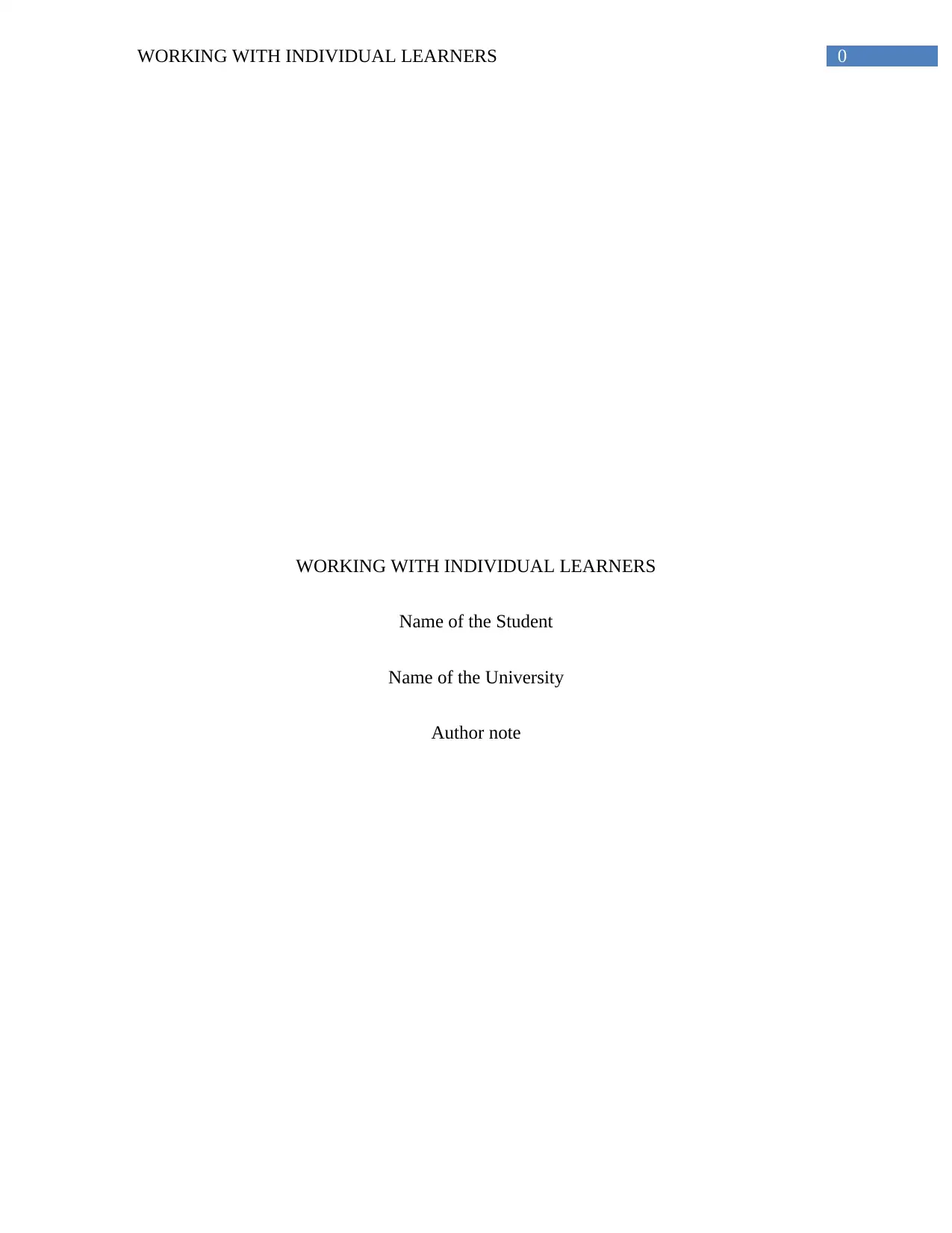
0WORKING WITH INDIVIDUAL LEARNERS
WORKING WITH INDIVIDUAL LEARNERS
Name of the Student
Name of the University
Author note
WORKING WITH INDIVIDUAL LEARNERS
Name of the Student
Name of the University
Author note
Paraphrase This Document
Need a fresh take? Get an instant paraphrase of this document with our AI Paraphraser
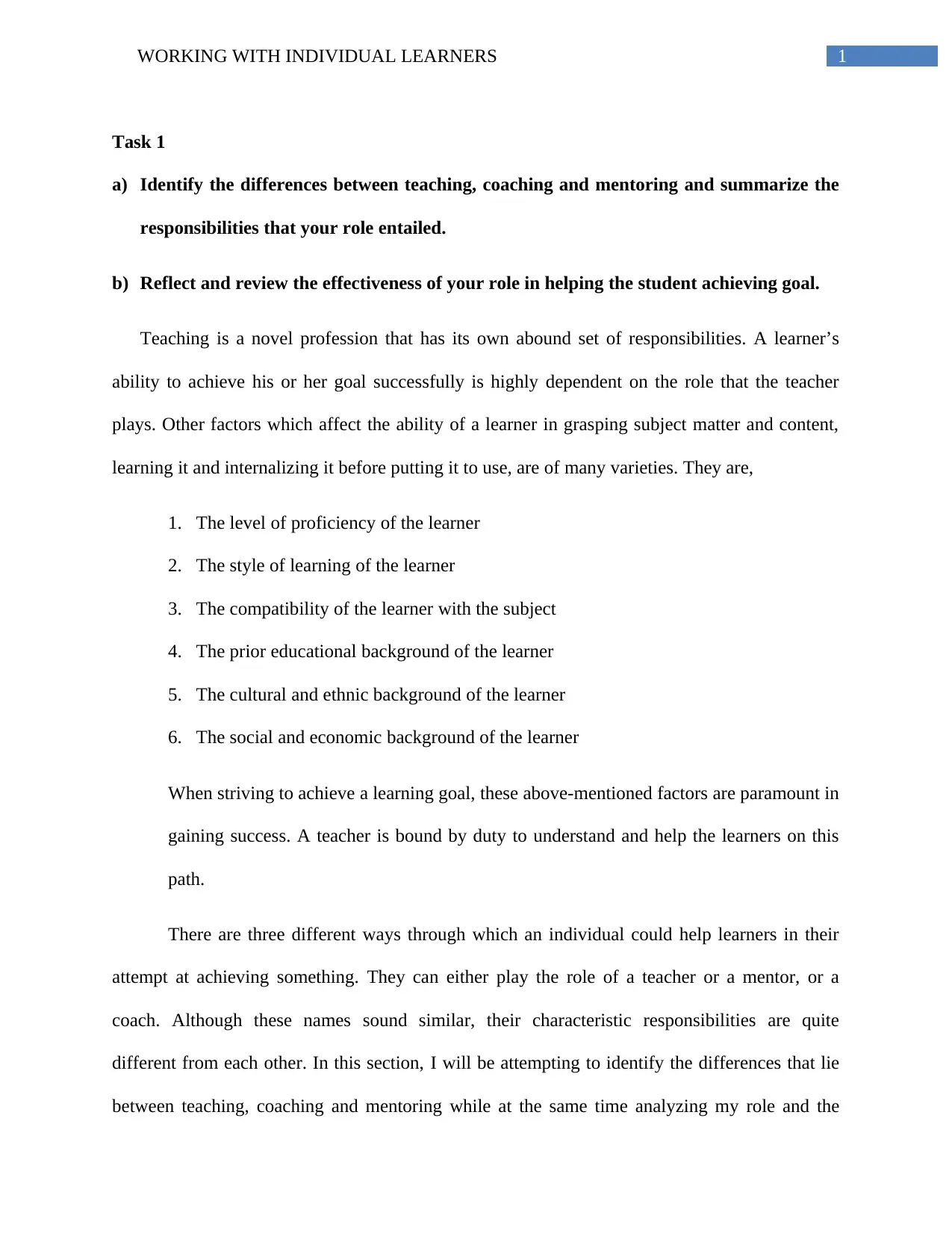
1WORKING WITH INDIVIDUAL LEARNERS
Task 1
a) Identify the differences between teaching, coaching and mentoring and summarize the
responsibilities that your role entailed.
b) Reflect and review the effectiveness of your role in helping the student achieving goal.
Teaching is a novel profession that has its own abound set of responsibilities. A learner’s
ability to achieve his or her goal successfully is highly dependent on the role that the teacher
plays. Other factors which affect the ability of a learner in grasping subject matter and content,
learning it and internalizing it before putting it to use, are of many varieties. They are,
1. The level of proficiency of the learner
2. The style of learning of the learner
3. The compatibility of the learner with the subject
4. The prior educational background of the learner
5. The cultural and ethnic background of the learner
6. The social and economic background of the learner
When striving to achieve a learning goal, these above-mentioned factors are paramount in
gaining success. A teacher is bound by duty to understand and help the learners on this
path.
There are three different ways through which an individual could help learners in their
attempt at achieving something. They can either play the role of a teacher or a mentor, or a
coach. Although these names sound similar, their characteristic responsibilities are quite
different from each other. In this section, I will be attempting to identify the differences that lie
between teaching, coaching and mentoring while at the same time analyzing my role and the
Task 1
a) Identify the differences between teaching, coaching and mentoring and summarize the
responsibilities that your role entailed.
b) Reflect and review the effectiveness of your role in helping the student achieving goal.
Teaching is a novel profession that has its own abound set of responsibilities. A learner’s
ability to achieve his or her goal successfully is highly dependent on the role that the teacher
plays. Other factors which affect the ability of a learner in grasping subject matter and content,
learning it and internalizing it before putting it to use, are of many varieties. They are,
1. The level of proficiency of the learner
2. The style of learning of the learner
3. The compatibility of the learner with the subject
4. The prior educational background of the learner
5. The cultural and ethnic background of the learner
6. The social and economic background of the learner
When striving to achieve a learning goal, these above-mentioned factors are paramount in
gaining success. A teacher is bound by duty to understand and help the learners on this
path.
There are three different ways through which an individual could help learners in their
attempt at achieving something. They can either play the role of a teacher or a mentor, or a
coach. Although these names sound similar, their characteristic responsibilities are quite
different from each other. In this section, I will be attempting to identify the differences that lie
between teaching, coaching and mentoring while at the same time analyzing my role and the
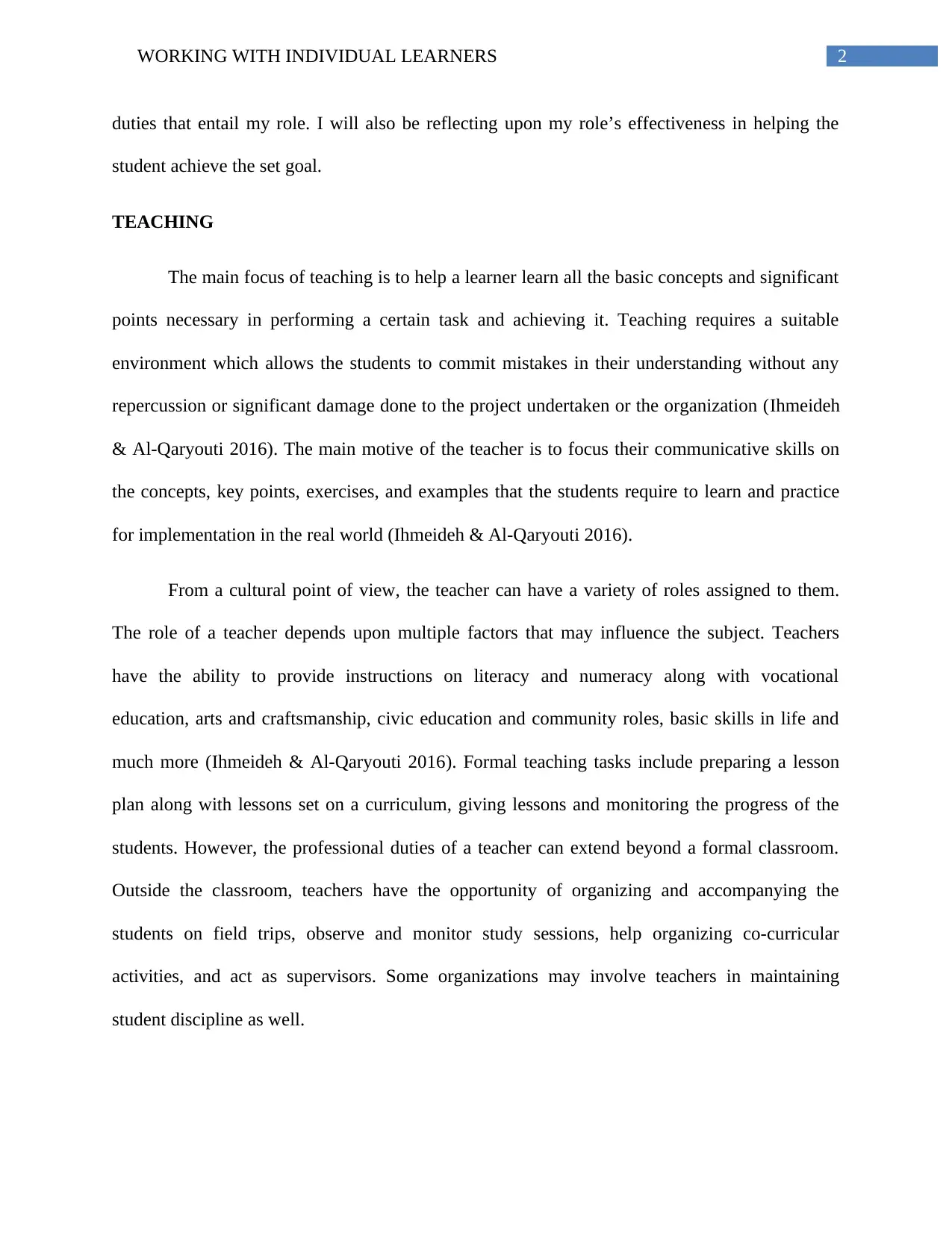
2WORKING WITH INDIVIDUAL LEARNERS
duties that entail my role. I will also be reflecting upon my role’s effectiveness in helping the
student achieve the set goal.
TEACHING
The main focus of teaching is to help a learner learn all the basic concepts and significant
points necessary in performing a certain task and achieving it. Teaching requires a suitable
environment which allows the students to commit mistakes in their understanding without any
repercussion or significant damage done to the project undertaken or the organization (Ihmeideh
& Al-Qaryouti 2016). The main motive of the teacher is to focus their communicative skills on
the concepts, key points, exercises, and examples that the students require to learn and practice
for implementation in the real world (Ihmeideh & Al-Qaryouti 2016).
From a cultural point of view, the teacher can have a variety of roles assigned to them.
The role of a teacher depends upon multiple factors that may influence the subject. Teachers
have the ability to provide instructions on literacy and numeracy along with vocational
education, arts and craftsmanship, civic education and community roles, basic skills in life and
much more (Ihmeideh & Al-Qaryouti 2016). Formal teaching tasks include preparing a lesson
plan along with lessons set on a curriculum, giving lessons and monitoring the progress of the
students. However, the professional duties of a teacher can extend beyond a formal classroom.
Outside the classroom, teachers have the opportunity of organizing and accompanying the
students on field trips, observe and monitor study sessions, help organizing co-curricular
activities, and act as supervisors. Some organizations may involve teachers in maintaining
student discipline as well.
duties that entail my role. I will also be reflecting upon my role’s effectiveness in helping the
student achieve the set goal.
TEACHING
The main focus of teaching is to help a learner learn all the basic concepts and significant
points necessary in performing a certain task and achieving it. Teaching requires a suitable
environment which allows the students to commit mistakes in their understanding without any
repercussion or significant damage done to the project undertaken or the organization (Ihmeideh
& Al-Qaryouti 2016). The main motive of the teacher is to focus their communicative skills on
the concepts, key points, exercises, and examples that the students require to learn and practice
for implementation in the real world (Ihmeideh & Al-Qaryouti 2016).
From a cultural point of view, the teacher can have a variety of roles assigned to them.
The role of a teacher depends upon multiple factors that may influence the subject. Teachers
have the ability to provide instructions on literacy and numeracy along with vocational
education, arts and craftsmanship, civic education and community roles, basic skills in life and
much more (Ihmeideh & Al-Qaryouti 2016). Formal teaching tasks include preparing a lesson
plan along with lessons set on a curriculum, giving lessons and monitoring the progress of the
students. However, the professional duties of a teacher can extend beyond a formal classroom.
Outside the classroom, teachers have the opportunity of organizing and accompanying the
students on field trips, observe and monitor study sessions, help organizing co-curricular
activities, and act as supervisors. Some organizations may involve teachers in maintaining
student discipline as well.
⊘ This is a preview!⊘
Do you want full access?
Subscribe today to unlock all pages.

Trusted by 1+ million students worldwide
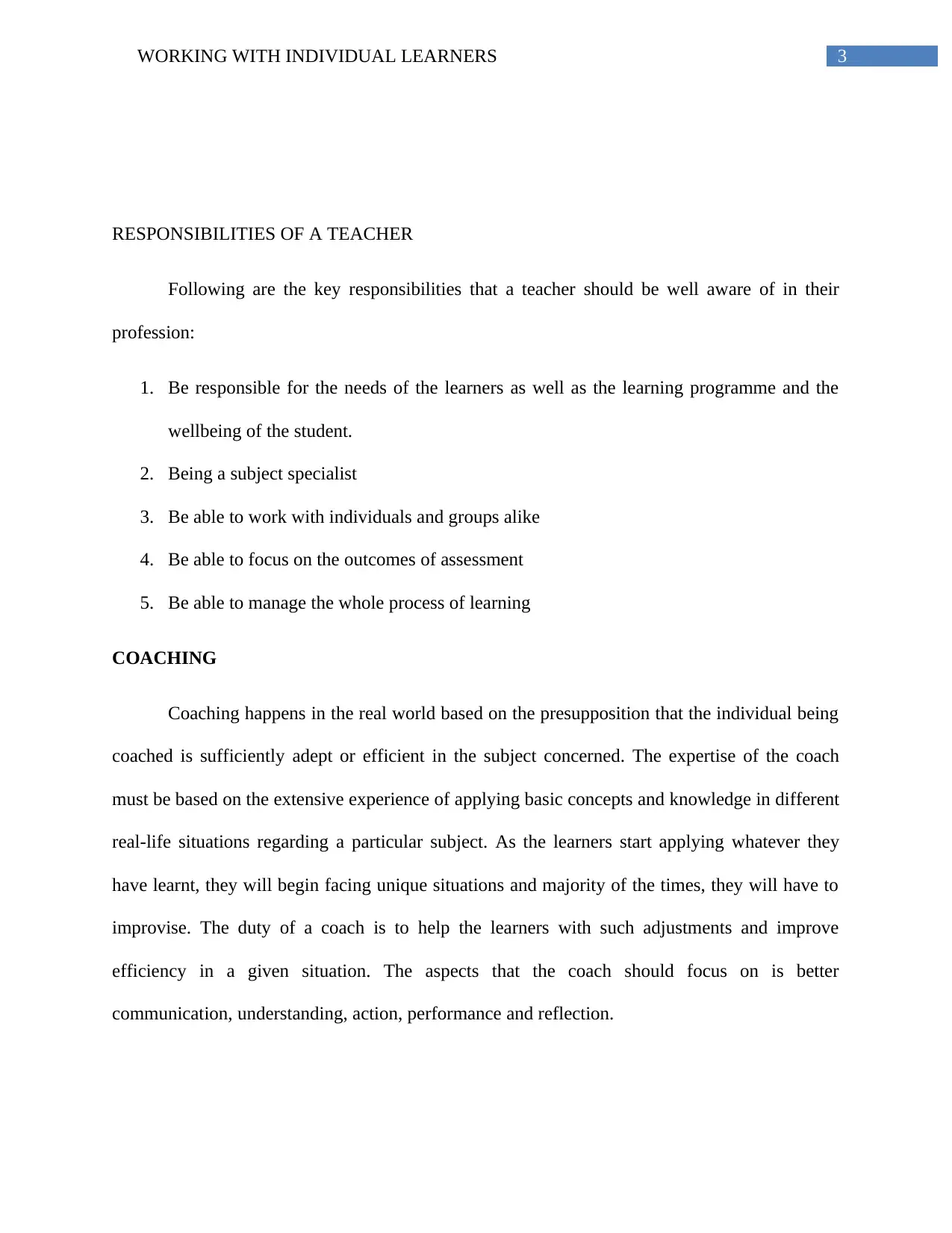
3WORKING WITH INDIVIDUAL LEARNERS
RESPONSIBILITIES OF A TEACHER
Following are the key responsibilities that a teacher should be well aware of in their
profession:
1. Be responsible for the needs of the learners as well as the learning programme and the
wellbeing of the student.
2. Being a subject specialist
3. Be able to work with individuals and groups alike
4. Be able to focus on the outcomes of assessment
5. Be able to manage the whole process of learning
COACHING
Coaching happens in the real world based on the presupposition that the individual being
coached is sufficiently adept or efficient in the subject concerned. The expertise of the coach
must be based on the extensive experience of applying basic concepts and knowledge in different
real-life situations regarding a particular subject. As the learners start applying whatever they
have learnt, they will begin facing unique situations and majority of the times, they will have to
improvise. The duty of a coach is to help the learners with such adjustments and improve
efficiency in a given situation. The aspects that the coach should focus on is better
communication, understanding, action, performance and reflection.
RESPONSIBILITIES OF A TEACHER
Following are the key responsibilities that a teacher should be well aware of in their
profession:
1. Be responsible for the needs of the learners as well as the learning programme and the
wellbeing of the student.
2. Being a subject specialist
3. Be able to work with individuals and groups alike
4. Be able to focus on the outcomes of assessment
5. Be able to manage the whole process of learning
COACHING
Coaching happens in the real world based on the presupposition that the individual being
coached is sufficiently adept or efficient in the subject concerned. The expertise of the coach
must be based on the extensive experience of applying basic concepts and knowledge in different
real-life situations regarding a particular subject. As the learners start applying whatever they
have learnt, they will begin facing unique situations and majority of the times, they will have to
improvise. The duty of a coach is to help the learners with such adjustments and improve
efficiency in a given situation. The aspects that the coach should focus on is better
communication, understanding, action, performance and reflection.
Paraphrase This Document
Need a fresh take? Get an instant paraphrase of this document with our AI Paraphraser
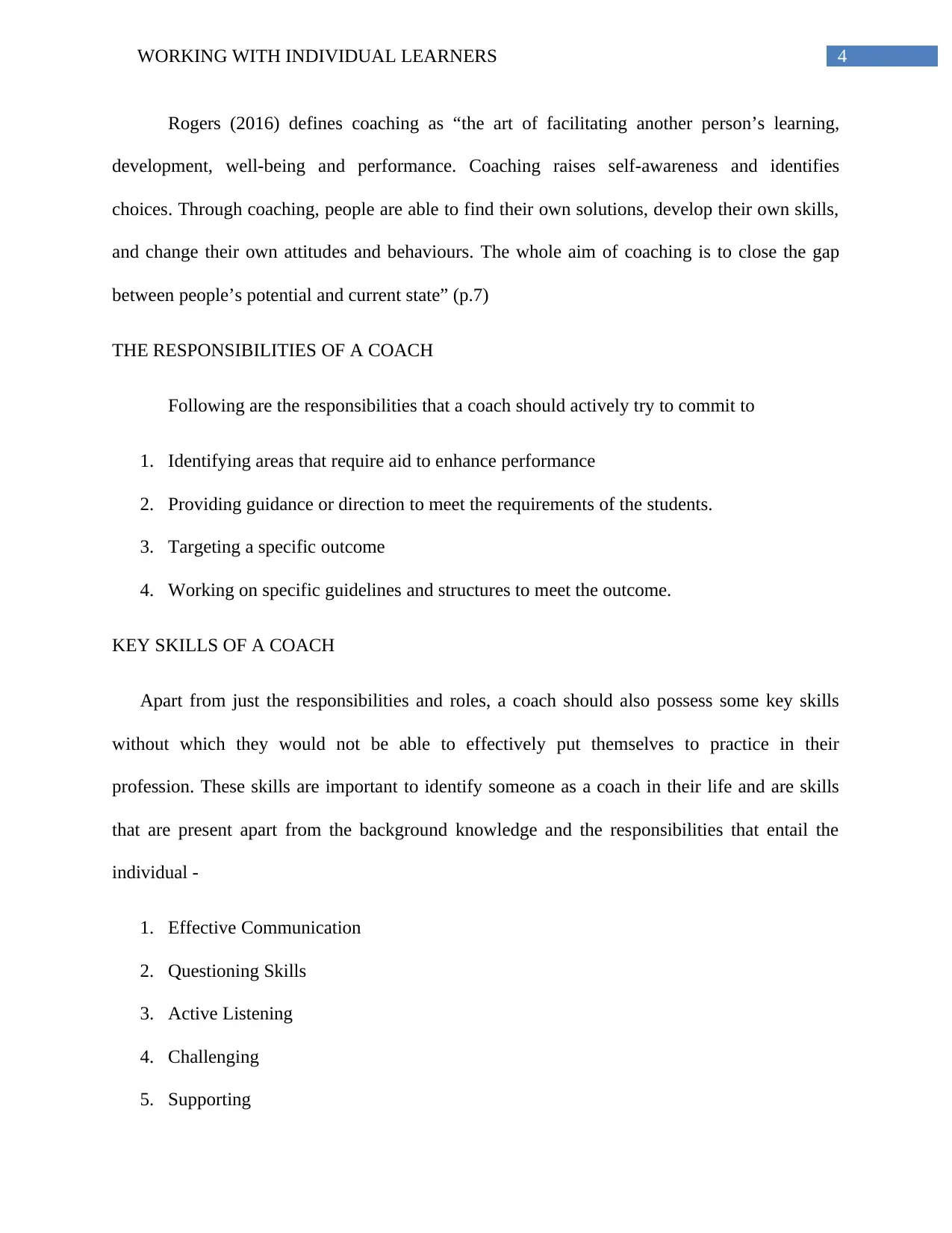
4WORKING WITH INDIVIDUAL LEARNERS
Rogers (2016) defines coaching as “the art of facilitating another person’s learning,
development, well-being and performance. Coaching raises self-awareness and identifies
choices. Through coaching, people are able to find their own solutions, develop their own skills,
and change their own attitudes and behaviours. The whole aim of coaching is to close the gap
between people’s potential and current state” (p.7)
THE RESPONSIBILITIES OF A COACH
Following are the responsibilities that a coach should actively try to commit to
1. Identifying areas that require aid to enhance performance
2. Providing guidance or direction to meet the requirements of the students.
3. Targeting a specific outcome
4. Working on specific guidelines and structures to meet the outcome.
KEY SKILLS OF A COACH
Apart from just the responsibilities and roles, a coach should also possess some key skills
without which they would not be able to effectively put themselves to practice in their
profession. These skills are important to identify someone as a coach in their life and are skills
that are present apart from the background knowledge and the responsibilities that entail the
individual -
1. Effective Communication
2. Questioning Skills
3. Active Listening
4. Challenging
5. Supporting
Rogers (2016) defines coaching as “the art of facilitating another person’s learning,
development, well-being and performance. Coaching raises self-awareness and identifies
choices. Through coaching, people are able to find their own solutions, develop their own skills,
and change their own attitudes and behaviours. The whole aim of coaching is to close the gap
between people’s potential and current state” (p.7)
THE RESPONSIBILITIES OF A COACH
Following are the responsibilities that a coach should actively try to commit to
1. Identifying areas that require aid to enhance performance
2. Providing guidance or direction to meet the requirements of the students.
3. Targeting a specific outcome
4. Working on specific guidelines and structures to meet the outcome.
KEY SKILLS OF A COACH
Apart from just the responsibilities and roles, a coach should also possess some key skills
without which they would not be able to effectively put themselves to practice in their
profession. These skills are important to identify someone as a coach in their life and are skills
that are present apart from the background knowledge and the responsibilities that entail the
individual -
1. Effective Communication
2. Questioning Skills
3. Active Listening
4. Challenging
5. Supporting
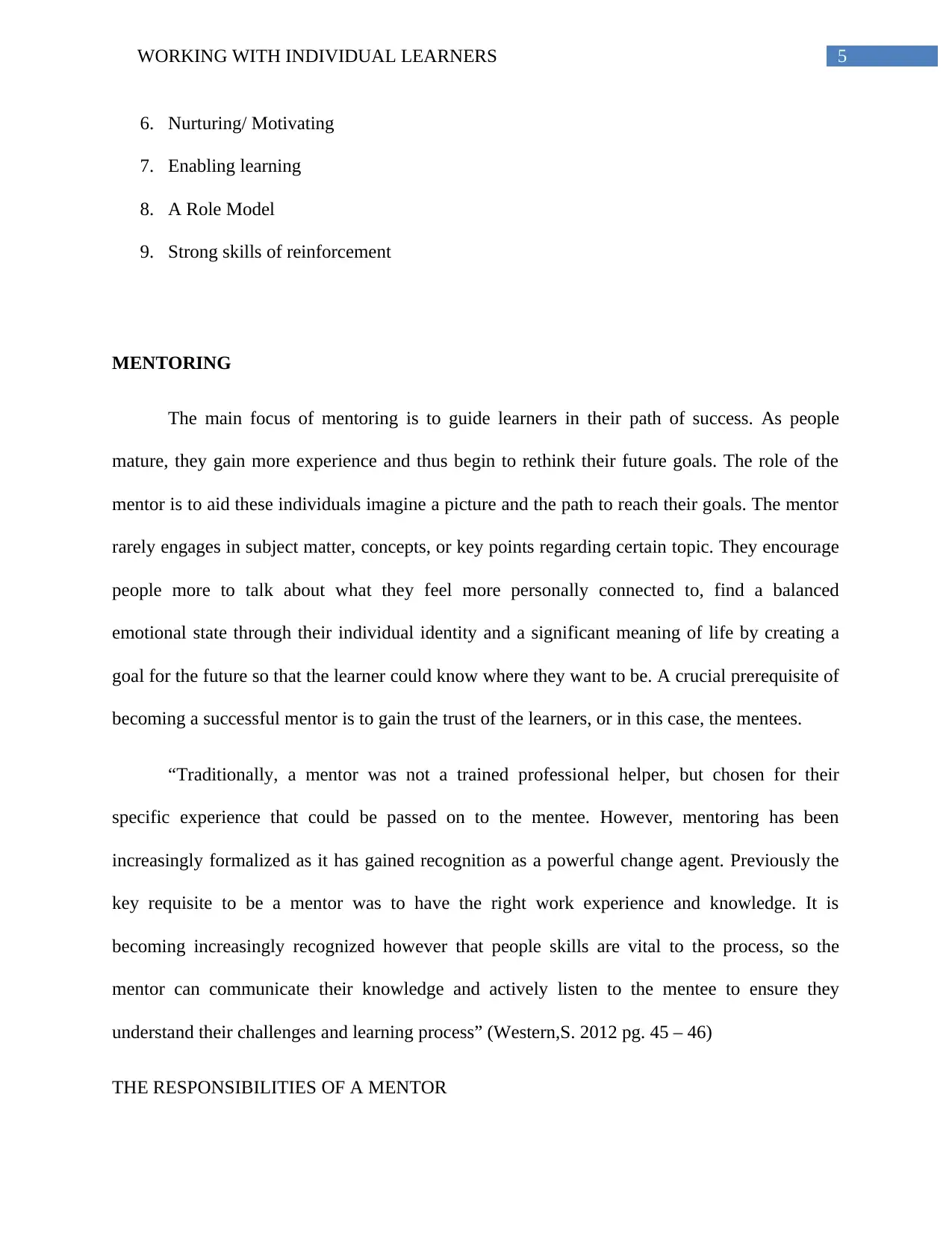
5WORKING WITH INDIVIDUAL LEARNERS
6. Nurturing/ Motivating
7. Enabling learning
8. A Role Model
9. Strong skills of reinforcement
MENTORING
The main focus of mentoring is to guide learners in their path of success. As people
mature, they gain more experience and thus begin to rethink their future goals. The role of the
mentor is to aid these individuals imagine a picture and the path to reach their goals. The mentor
rarely engages in subject matter, concepts, or key points regarding certain topic. They encourage
people more to talk about what they feel more personally connected to, find a balanced
emotional state through their individual identity and a significant meaning of life by creating a
goal for the future so that the learner could know where they want to be. A crucial prerequisite of
becoming a successful mentor is to gain the trust of the learners, or in this case, the mentees.
“Traditionally, a mentor was not a trained professional helper, but chosen for their
specific experience that could be passed on to the mentee. However, mentoring has been
increasingly formalized as it has gained recognition as a powerful change agent. Previously the
key requisite to be a mentor was to have the right work experience and knowledge. It is
becoming increasingly recognized however that people skills are vital to the process, so the
mentor can communicate their knowledge and actively listen to the mentee to ensure they
understand their challenges and learning process” (Western,S. 2012 pg. 45 – 46)
THE RESPONSIBILITIES OF A MENTOR
6. Nurturing/ Motivating
7. Enabling learning
8. A Role Model
9. Strong skills of reinforcement
MENTORING
The main focus of mentoring is to guide learners in their path of success. As people
mature, they gain more experience and thus begin to rethink their future goals. The role of the
mentor is to aid these individuals imagine a picture and the path to reach their goals. The mentor
rarely engages in subject matter, concepts, or key points regarding certain topic. They encourage
people more to talk about what they feel more personally connected to, find a balanced
emotional state through their individual identity and a significant meaning of life by creating a
goal for the future so that the learner could know where they want to be. A crucial prerequisite of
becoming a successful mentor is to gain the trust of the learners, or in this case, the mentees.
“Traditionally, a mentor was not a trained professional helper, but chosen for their
specific experience that could be passed on to the mentee. However, mentoring has been
increasingly formalized as it has gained recognition as a powerful change agent. Previously the
key requisite to be a mentor was to have the right work experience and knowledge. It is
becoming increasingly recognized however that people skills are vital to the process, so the
mentor can communicate their knowledge and actively listen to the mentee to ensure they
understand their challenges and learning process” (Western,S. 2012 pg. 45 – 46)
THE RESPONSIBILITIES OF A MENTOR
⊘ This is a preview!⊘
Do you want full access?
Subscribe today to unlock all pages.

Trusted by 1+ million students worldwide
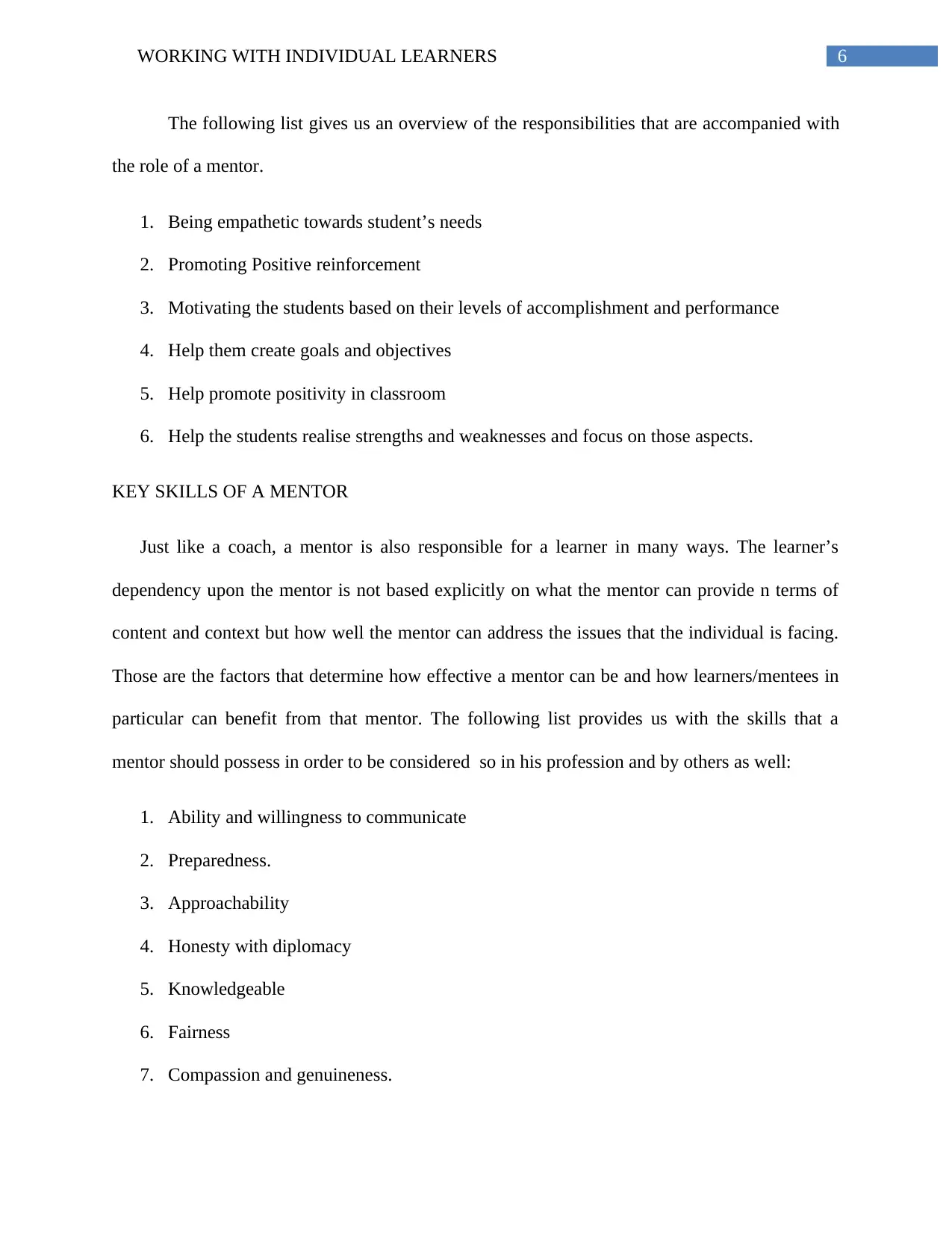
6WORKING WITH INDIVIDUAL LEARNERS
The following list gives us an overview of the responsibilities that are accompanied with
the role of a mentor.
1. Being empathetic towards student’s needs
2. Promoting Positive reinforcement
3. Motivating the students based on their levels of accomplishment and performance
4. Help them create goals and objectives
5. Help promote positivity in classroom
6. Help the students realise strengths and weaknesses and focus on those aspects.
KEY SKILLS OF A MENTOR
Just like a coach, a mentor is also responsible for a learner in many ways. The learner’s
dependency upon the mentor is not based explicitly on what the mentor can provide n terms of
content and context but how well the mentor can address the issues that the individual is facing.
Those are the factors that determine how effective a mentor can be and how learners/mentees in
particular can benefit from that mentor. The following list provides us with the skills that a
mentor should possess in order to be considered so in his profession and by others as well:
1. Ability and willingness to communicate
2. Preparedness.
3. Approachability
4. Honesty with diplomacy
5. Knowledgeable
6. Fairness
7. Compassion and genuineness.
The following list gives us an overview of the responsibilities that are accompanied with
the role of a mentor.
1. Being empathetic towards student’s needs
2. Promoting Positive reinforcement
3. Motivating the students based on their levels of accomplishment and performance
4. Help them create goals and objectives
5. Help promote positivity in classroom
6. Help the students realise strengths and weaknesses and focus on those aspects.
KEY SKILLS OF A MENTOR
Just like a coach, a mentor is also responsible for a learner in many ways. The learner’s
dependency upon the mentor is not based explicitly on what the mentor can provide n terms of
content and context but how well the mentor can address the issues that the individual is facing.
Those are the factors that determine how effective a mentor can be and how learners/mentees in
particular can benefit from that mentor. The following list provides us with the skills that a
mentor should possess in order to be considered so in his profession and by others as well:
1. Ability and willingness to communicate
2. Preparedness.
3. Approachability
4. Honesty with diplomacy
5. Knowledgeable
6. Fairness
7. Compassion and genuineness.
Paraphrase This Document
Need a fresh take? Get an instant paraphrase of this document with our AI Paraphraser
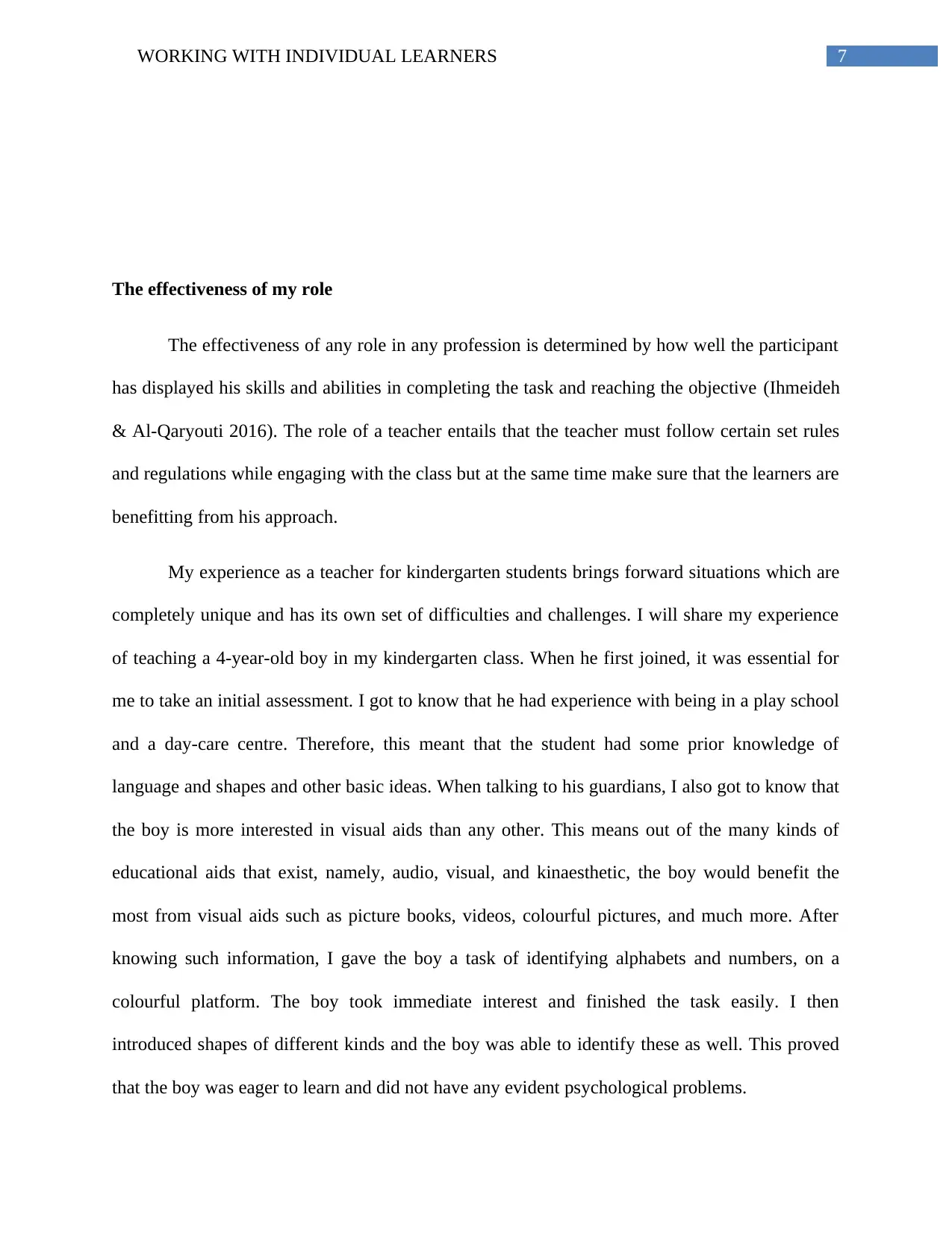
7WORKING WITH INDIVIDUAL LEARNERS
The effectiveness of my role
The effectiveness of any role in any profession is determined by how well the participant
has displayed his skills and abilities in completing the task and reaching the objective (Ihmeideh
& Al-Qaryouti 2016). The role of a teacher entails that the teacher must follow certain set rules
and regulations while engaging with the class but at the same time make sure that the learners are
benefitting from his approach.
My experience as a teacher for kindergarten students brings forward situations which are
completely unique and has its own set of difficulties and challenges. I will share my experience
of teaching a 4-year-old boy in my kindergarten class. When he first joined, it was essential for
me to take an initial assessment. I got to know that he had experience with being in a play school
and a day-care centre. Therefore, this meant that the student had some prior knowledge of
language and shapes and other basic ideas. When talking to his guardians, I also got to know that
the boy is more interested in visual aids than any other. This means out of the many kinds of
educational aids that exist, namely, audio, visual, and kinaesthetic, the boy would benefit the
most from visual aids such as picture books, videos, colourful pictures, and much more. After
knowing such information, I gave the boy a task of identifying alphabets and numbers, on a
colourful platform. The boy took immediate interest and finished the task easily. I then
introduced shapes of different kinds and the boy was able to identify these as well. This proved
that the boy was eager to learn and did not have any evident psychological problems.
The effectiveness of my role
The effectiveness of any role in any profession is determined by how well the participant
has displayed his skills and abilities in completing the task and reaching the objective (Ihmeideh
& Al-Qaryouti 2016). The role of a teacher entails that the teacher must follow certain set rules
and regulations while engaging with the class but at the same time make sure that the learners are
benefitting from his approach.
My experience as a teacher for kindergarten students brings forward situations which are
completely unique and has its own set of difficulties and challenges. I will share my experience
of teaching a 4-year-old boy in my kindergarten class. When he first joined, it was essential for
me to take an initial assessment. I got to know that he had experience with being in a play school
and a day-care centre. Therefore, this meant that the student had some prior knowledge of
language and shapes and other basic ideas. When talking to his guardians, I also got to know that
the boy is more interested in visual aids than any other. This means out of the many kinds of
educational aids that exist, namely, audio, visual, and kinaesthetic, the boy would benefit the
most from visual aids such as picture books, videos, colourful pictures, and much more. After
knowing such information, I gave the boy a task of identifying alphabets and numbers, on a
colourful platform. The boy took immediate interest and finished the task easily. I then
introduced shapes of different kinds and the boy was able to identify these as well. This proved
that the boy was eager to learn and did not have any evident psychological problems.
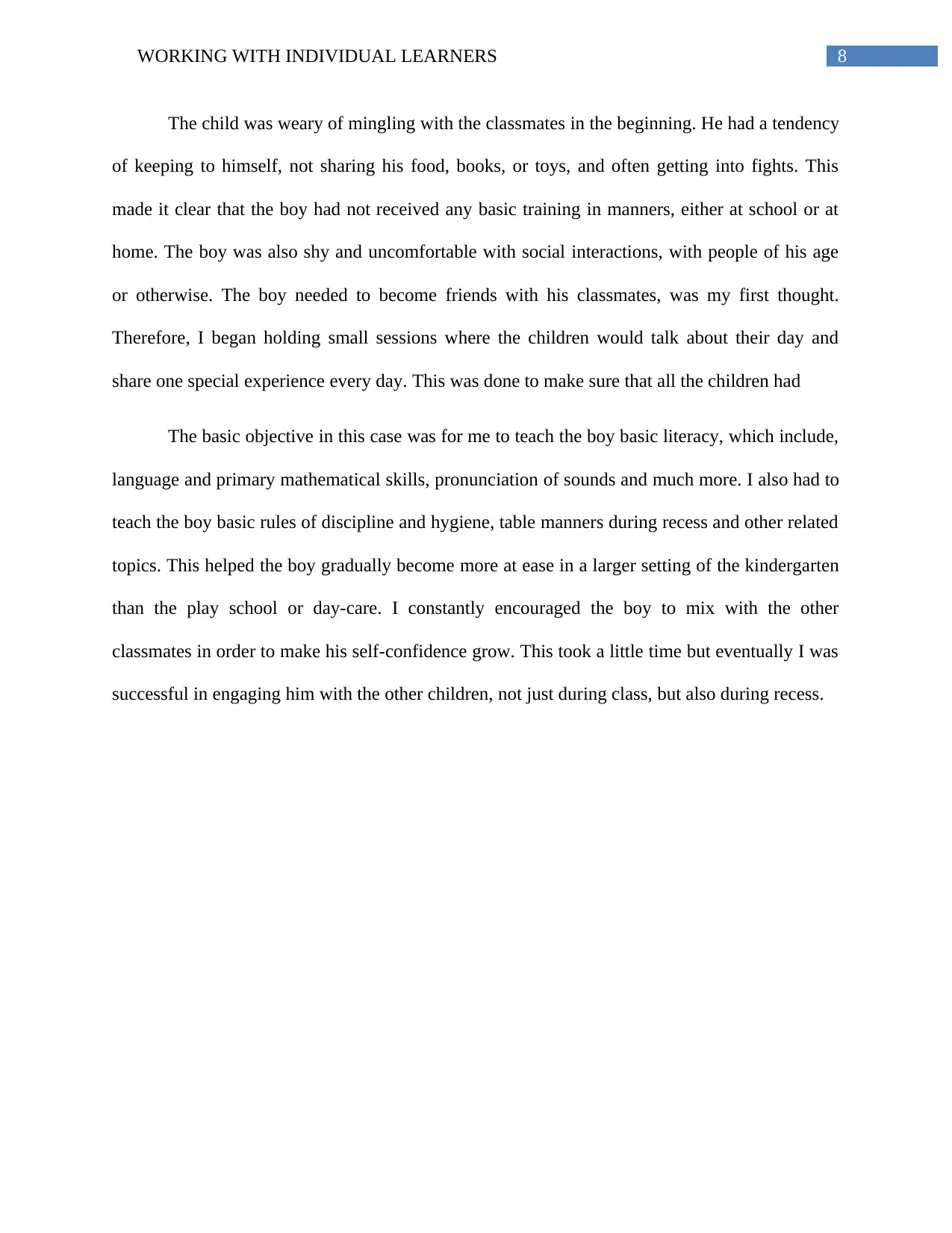
8WORKING WITH INDIVIDUAL LEARNERS
The child was weary of mingling with the classmates in the beginning. He had a tendency
of keeping to himself, not sharing his food, books, or toys, and often getting into fights. This
made it clear that the boy had not received any basic training in manners, either at school or at
home. The boy was also shy and uncomfortable with social interactions, with people of his age
or otherwise. The boy needed to become friends with his classmates, was my first thought.
Therefore, I began holding small sessions where the children would talk about their day and
share one special experience every day. This was done to make sure that all the children had
The basic objective in this case was for me to teach the boy basic literacy, which include,
language and primary mathematical skills, pronunciation of sounds and much more. I also had to
teach the boy basic rules of discipline and hygiene, table manners during recess and other related
topics. This helped the boy gradually become more at ease in a larger setting of the kindergarten
than the play school or day-care. I constantly encouraged the boy to mix with the other
classmates in order to make his self-confidence grow. This took a little time but eventually I was
successful in engaging him with the other children, not just during class, but also during recess.
The child was weary of mingling with the classmates in the beginning. He had a tendency
of keeping to himself, not sharing his food, books, or toys, and often getting into fights. This
made it clear that the boy had not received any basic training in manners, either at school or at
home. The boy was also shy and uncomfortable with social interactions, with people of his age
or otherwise. The boy needed to become friends with his classmates, was my first thought.
Therefore, I began holding small sessions where the children would talk about their day and
share one special experience every day. This was done to make sure that all the children had
The basic objective in this case was for me to teach the boy basic literacy, which include,
language and primary mathematical skills, pronunciation of sounds and much more. I also had to
teach the boy basic rules of discipline and hygiene, table manners during recess and other related
topics. This helped the boy gradually become more at ease in a larger setting of the kindergarten
than the play school or day-care. I constantly encouraged the boy to mix with the other
classmates in order to make his self-confidence grow. This took a little time but eventually I was
successful in engaging him with the other children, not just during class, but also during recess.
⊘ This is a preview!⊘
Do you want full access?
Subscribe today to unlock all pages.

Trusted by 1+ million students worldwide
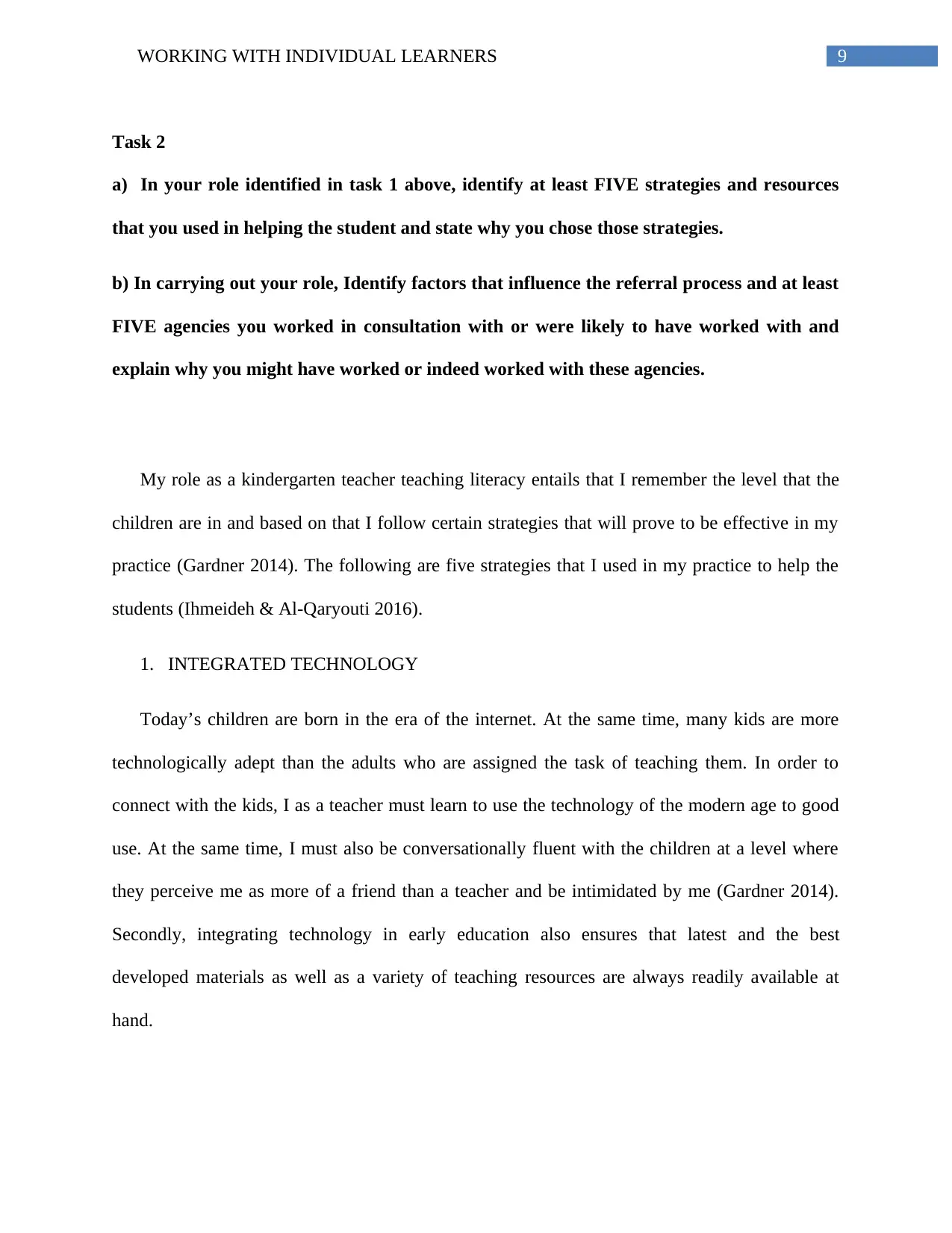
9WORKING WITH INDIVIDUAL LEARNERS
Task 2
a) In your role identified in task 1 above, identify at least FIVE strategies and resources
that you used in helping the student and state why you chose those strategies.
b) In carrying out your role, Identify factors that influence the referral process and at least
FIVE agencies you worked in consultation with or were likely to have worked with and
explain why you might have worked or indeed worked with these agencies.
My role as a kindergarten teacher teaching literacy entails that I remember the level that the
children are in and based on that I follow certain strategies that will prove to be effective in my
practice (Gardner 2014). The following are five strategies that I used in my practice to help the
students (Ihmeideh & Al-Qaryouti 2016).
1. INTEGRATED TECHNOLOGY
Today’s children are born in the era of the internet. At the same time, many kids are more
technologically adept than the adults who are assigned the task of teaching them. In order to
connect with the kids, I as a teacher must learn to use the technology of the modern age to good
use. At the same time, I must also be conversationally fluent with the children at a level where
they perceive me as more of a friend than a teacher and be intimidated by me (Gardner 2014).
Secondly, integrating technology in early education also ensures that latest and the best
developed materials as well as a variety of teaching resources are always readily available at
hand.
Task 2
a) In your role identified in task 1 above, identify at least FIVE strategies and resources
that you used in helping the student and state why you chose those strategies.
b) In carrying out your role, Identify factors that influence the referral process and at least
FIVE agencies you worked in consultation with or were likely to have worked with and
explain why you might have worked or indeed worked with these agencies.
My role as a kindergarten teacher teaching literacy entails that I remember the level that the
children are in and based on that I follow certain strategies that will prove to be effective in my
practice (Gardner 2014). The following are five strategies that I used in my practice to help the
students (Ihmeideh & Al-Qaryouti 2016).
1. INTEGRATED TECHNOLOGY
Today’s children are born in the era of the internet. At the same time, many kids are more
technologically adept than the adults who are assigned the task of teaching them. In order to
connect with the kids, I as a teacher must learn to use the technology of the modern age to good
use. At the same time, I must also be conversationally fluent with the children at a level where
they perceive me as more of a friend than a teacher and be intimidated by me (Gardner 2014).
Secondly, integrating technology in early education also ensures that latest and the best
developed materials as well as a variety of teaching resources are always readily available at
hand.
Paraphrase This Document
Need a fresh take? Get an instant paraphrase of this document with our AI Paraphraser
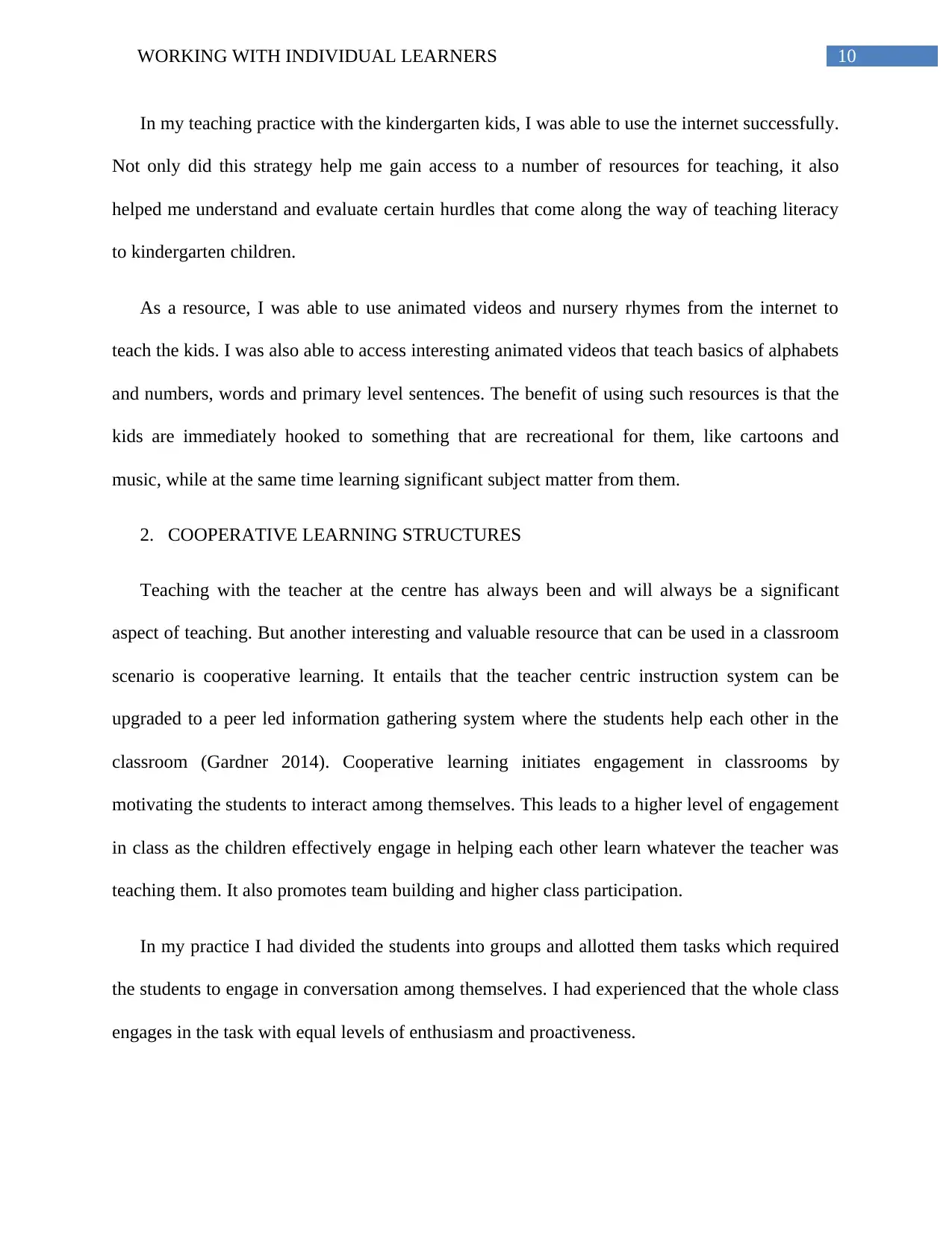
10WORKING WITH INDIVIDUAL LEARNERS
In my teaching practice with the kindergarten kids, I was able to use the internet successfully.
Not only did this strategy help me gain access to a number of resources for teaching, it also
helped me understand and evaluate certain hurdles that come along the way of teaching literacy
to kindergarten children.
As a resource, I was able to use animated videos and nursery rhymes from the internet to
teach the kids. I was also able to access interesting animated videos that teach basics of alphabets
and numbers, words and primary level sentences. The benefit of using such resources is that the
kids are immediately hooked to something that are recreational for them, like cartoons and
music, while at the same time learning significant subject matter from them.
2. COOPERATIVE LEARNING STRUCTURES
Teaching with the teacher at the centre has always been and will always be a significant
aspect of teaching. But another interesting and valuable resource that can be used in a classroom
scenario is cooperative learning. It entails that the teacher centric instruction system can be
upgraded to a peer led information gathering system where the students help each other in the
classroom (Gardner 2014). Cooperative learning initiates engagement in classrooms by
motivating the students to interact among themselves. This leads to a higher level of engagement
in class as the children effectively engage in helping each other learn whatever the teacher was
teaching them. It also promotes team building and higher class participation.
In my practice I had divided the students into groups and allotted them tasks which required
the students to engage in conversation among themselves. I had experienced that the whole class
engages in the task with equal levels of enthusiasm and proactiveness.
In my teaching practice with the kindergarten kids, I was able to use the internet successfully.
Not only did this strategy help me gain access to a number of resources for teaching, it also
helped me understand and evaluate certain hurdles that come along the way of teaching literacy
to kindergarten children.
As a resource, I was able to use animated videos and nursery rhymes from the internet to
teach the kids. I was also able to access interesting animated videos that teach basics of alphabets
and numbers, words and primary level sentences. The benefit of using such resources is that the
kids are immediately hooked to something that are recreational for them, like cartoons and
music, while at the same time learning significant subject matter from them.
2. COOPERATIVE LEARNING STRUCTURES
Teaching with the teacher at the centre has always been and will always be a significant
aspect of teaching. But another interesting and valuable resource that can be used in a classroom
scenario is cooperative learning. It entails that the teacher centric instruction system can be
upgraded to a peer led information gathering system where the students help each other in the
classroom (Gardner 2014). Cooperative learning initiates engagement in classrooms by
motivating the students to interact among themselves. This leads to a higher level of engagement
in class as the children effectively engage in helping each other learn whatever the teacher was
teaching them. It also promotes team building and higher class participation.
In my practice I had divided the students into groups and allotted them tasks which required
the students to engage in conversation among themselves. I had experienced that the whole class
engages in the task with equal levels of enthusiasm and proactiveness.
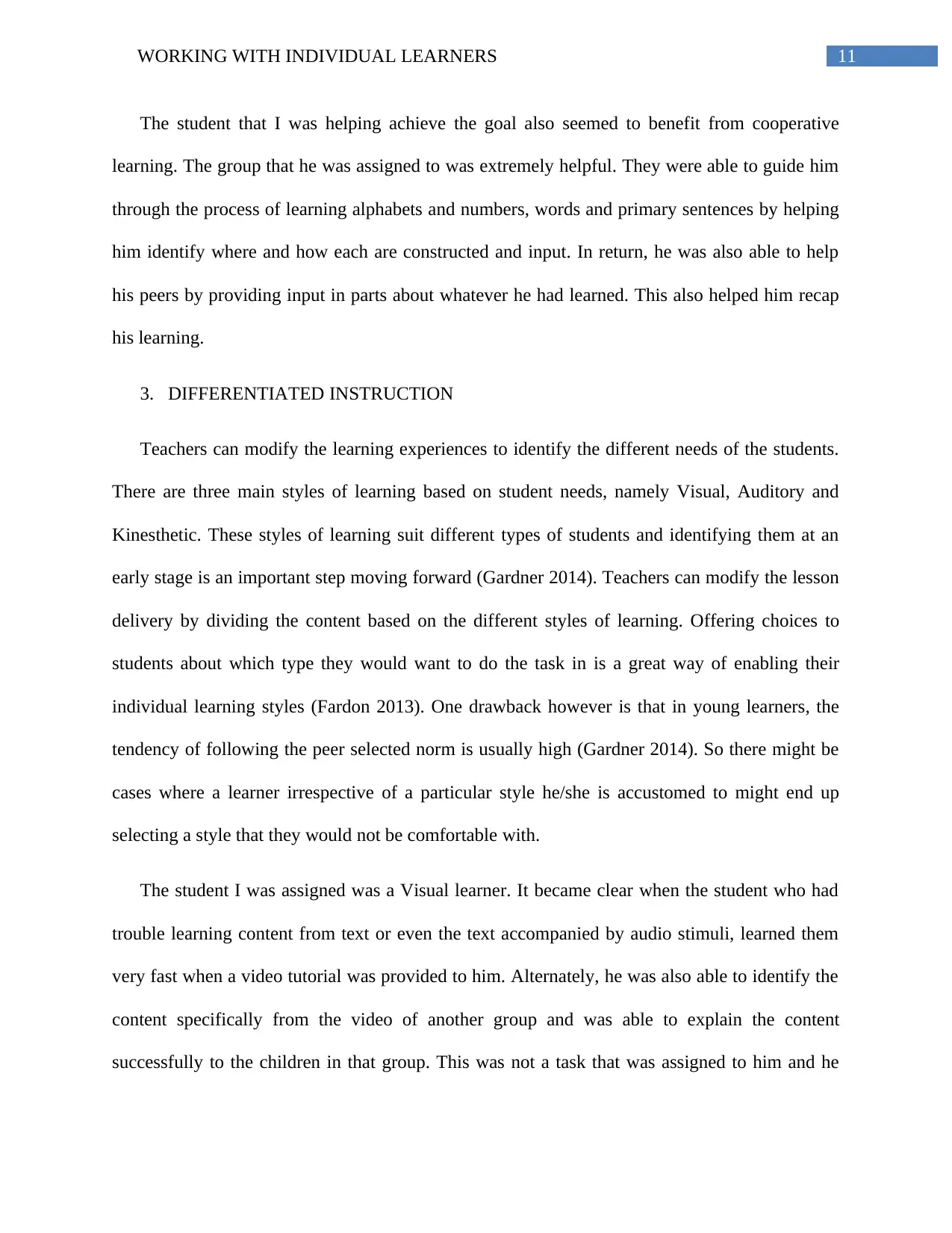
11WORKING WITH INDIVIDUAL LEARNERS
The student that I was helping achieve the goal also seemed to benefit from cooperative
learning. The group that he was assigned to was extremely helpful. They were able to guide him
through the process of learning alphabets and numbers, words and primary sentences by helping
him identify where and how each are constructed and input. In return, he was also able to help
his peers by providing input in parts about whatever he had learned. This also helped him recap
his learning.
3. DIFFERENTIATED INSTRUCTION
Teachers can modify the learning experiences to identify the different needs of the students.
There are three main styles of learning based on student needs, namely Visual, Auditory and
Kinesthetic. These styles of learning suit different types of students and identifying them at an
early stage is an important step moving forward (Gardner 2014). Teachers can modify the lesson
delivery by dividing the content based on the different styles of learning. Offering choices to
students about which type they would want to do the task in is a great way of enabling their
individual learning styles (Fardon 2013). One drawback however is that in young learners, the
tendency of following the peer selected norm is usually high (Gardner 2014). So there might be
cases where a learner irrespective of a particular style he/she is accustomed to might end up
selecting a style that they would not be comfortable with.
The student I was assigned was a Visual learner. It became clear when the student who had
trouble learning content from text or even the text accompanied by audio stimuli, learned them
very fast when a video tutorial was provided to him. Alternately, he was also able to identify the
content specifically from the video of another group and was able to explain the content
successfully to the children in that group. This was not a task that was assigned to him and he
The student that I was helping achieve the goal also seemed to benefit from cooperative
learning. The group that he was assigned to was extremely helpful. They were able to guide him
through the process of learning alphabets and numbers, words and primary sentences by helping
him identify where and how each are constructed and input. In return, he was also able to help
his peers by providing input in parts about whatever he had learned. This also helped him recap
his learning.
3. DIFFERENTIATED INSTRUCTION
Teachers can modify the learning experiences to identify the different needs of the students.
There are three main styles of learning based on student needs, namely Visual, Auditory and
Kinesthetic. These styles of learning suit different types of students and identifying them at an
early stage is an important step moving forward (Gardner 2014). Teachers can modify the lesson
delivery by dividing the content based on the different styles of learning. Offering choices to
students about which type they would want to do the task in is a great way of enabling their
individual learning styles (Fardon 2013). One drawback however is that in young learners, the
tendency of following the peer selected norm is usually high (Gardner 2014). So there might be
cases where a learner irrespective of a particular style he/she is accustomed to might end up
selecting a style that they would not be comfortable with.
The student I was assigned was a Visual learner. It became clear when the student who had
trouble learning content from text or even the text accompanied by audio stimuli, learned them
very fast when a video tutorial was provided to him. Alternately, he was also able to identify the
content specifically from the video of another group and was able to explain the content
successfully to the children in that group. This was not a task that was assigned to him and he
⊘ This is a preview!⊘
Do you want full access?
Subscribe today to unlock all pages.

Trusted by 1+ million students worldwide
1 out of 24
Related Documents
Your All-in-One AI-Powered Toolkit for Academic Success.
+13062052269
info@desklib.com
Available 24*7 on WhatsApp / Email
![[object Object]](/_next/static/media/star-bottom.7253800d.svg)
Unlock your academic potential
Copyright © 2020–2025 A2Z Services. All Rights Reserved. Developed and managed by ZUCOL.




